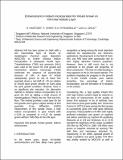| dc.contributor.author | Hartono, Haryono | |
| dc.contributor.author | Chen, P. | |
| dc.contributor.author | Fitzgerald, Eugene A. | |
| dc.contributor.author | Chua, Soo-Jin | |
| dc.date.accessioned | 2005-12-12T17:24:56Z | |
| dc.date.available | 2005-12-12T17:24:56Z | |
| dc.date.issued | 2006-01 | |
| dc.identifier.uri | http://hdl.handle.net/1721.1/29819 | |
| dc.description.abstract | InN has been grown on GaN with a thin intermediate layer of InGaN by metalorganic chemical vapor deposition (MOCVD) to further enhance indium incorporation in subsequent InGaN layer. Trimethylindium (TMI) and ammonia (NH₃) were used as the source for InN growth and transmission electron microscopy (TEM) confirmed the presence of pyramid-like structure of InN. A layer of InGaN subsequently grown on top of these InN pyramids shows a red-shift of ~20 nm relative to InGaN layer grown directly on GaN using the same growth condition. However, there is no significant pits reduction. An alternative method to enhance indium incorporation is to grow the InN by adding a small amount of trimethygallium (TMG) into the TMI and NH₃ flow. This method provides a seed layer for the InN growth and it gives a higher density of InN pyramids. X-ray diffraction (XRD) measurement of this sample shows a high indium incorporation to give InGaN with x~0.26 as compared to x~0.22 for sample grown without TMG flow in the InN layer. | en |
| dc.description.sponsorship | Singapore-MIT Alliance (SMA) | en |
| dc.format.extent | 763949 bytes | |
| dc.format.mimetype | application/pdf | |
| dc.language.iso | en | en |
| dc.relation.ispartofseries | Advanced Materials for Micro- and Nano-Systems (AMMNS) | en |
| dc.subject | InN growth | en |
| dc.subject | InGaN growth | en |
| dc.subject | Indium enhancement | en |
| dc.title | Enhancement in Indium Incorporation for InGaN Grown on InN Intermediate Layer | en |
| dc.type | Article | en |

